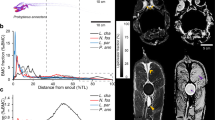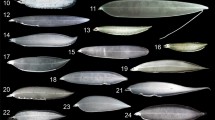Abstract
Many planktonic organisms have adaptations such as floats or lighter substances to obtain buoyancy to help them remain in the surface layer of the ocean where photosynthetic primary production occurs and food is most abundant. The almost totally transparent eel larvae, called leptocephali, are a unique member of the planktonic community of the surface layer, but their ecology and physiology are poorly understood. We conducted a comparative study on the specific gravity of planktonic animals including 25 taxa of 7 phyla of marine invertebrates and 6 taxa of leptocephali (vertebrate) to gain a broad perspective on the buoyancy of the eggs and larval stages of the Japanese eel. The specific gravity values of the various freshly caught marine invertebrate taxa varied widely from 1.020 to 1.425, but leptocephali had some of the lowest values (1.028–1.043). Artificially cultured live leptocephali had even greater buoyancies with specific gravities of 1.019–1.025 that were close to or lower than seawater, and their buoyancy showed ontogenetic changes among the different early life history stages. Leptocephali appear to have a unique mechanism of buoyancy control by chloride cells all over body surface through osmoregulation of body fluid contained in the extracellular matrix of transparent gelatinous glycosaminoglycans filling their bodies. This adaptation is likely a key factor for their survival by helping them to remain in the surface layer where food particles are the most abundant, while being transparent for predator avoidance. The ontogenetic change in buoyancy of eel eggs, leptocephali and glass eels likely enhances their larval survival, transport, and recruitment to terrestrial freshwater habitats.





Similar content being viewed by others
References
Alexander M (1990) Size, speed and buoyancy adaptations in aquatic animals. Am Zool 30:189–196
Bishop RE, Torres JJ, Crabtree RE (2000) Chemical composition and growth indices in leptocephalus larvae. Mar Biol (Berl) 137:205–214. doi:https://doi.org/10.1007/s002270000362
Bonhommeau S, Chassot E, Rivot E (2008) Fluctuations in European eel (Anguilla anguilla) recruitment resulting from environmental changes in the Sargasso Sea. Fish Oceanogr 17:32–44
Campbell RW, Dower JF (2003) Role of lipids in the maintenance of neutral buoyancy by zooplankton. Mar Ecol Prog Ser 263:93–99. doi:https://doi.org/10.3354/meps263093
Castonguay M, McCleave JD (1987) Vertical distributions, diel and ontogenetic vertical migrations and net avoidance of leptocephali of Anguilla and other common species in the Sargasso Sea. J Plankton Res 9:195–214
Davenport J (1994) Observations on the locomotion and buoyancy of Phronima sedentaria (Forskål, 1775) (Crustacea: Amphipoda: Hyperiidea). J Nat Hist 28:787–793. doi:https://doi.org/10.1080/00222939400770401
Donnelly J, Torres JJ, Crabtree RE (1995) Proximate composition and nucleic acid content of premetamorphic leptocephalus larvae of the congrid eel Ariosoma balearicum. Mar Biol (Berl) 123:851–858. doi:https://doi.org/10.1007/BF00349130
Dou SZ, Yamada Y, Okamura A, Shinoda A, Tanaka S, Tsukamoto K (2008) Temperature influence on the spawning performance of artificially-matured Japanese eel, Anguilla japonica, in captivity. Environ Biol Fishes 82:151–164. doi:https://doi.org/10.1007/s10641-007-9268-8
Friedland KD, Miller MJ, Knights B (2007) Oceanic changes in the Sargasso Sea and declines in recruitment of the European eel. ICES J Mar Sci 64:519–530. doi:https://doi.org/10.1093/icesjms/fsm022
Hare JA, Walsh HJ, Wuenschel MJ (2006) Sinking rates of late-stage fish larvae: Implications for larval ingress into estuarine nursery habitats. J Exp Mar Biol Ecol 330:493–504. doi:https://doi.org/10.1016/j.jembe.2005.09.011
Hebel DV, Karl DM (2001) Seasonal, interannual and decadal variations in particulate matter concentrations and composition in the subtropical. North Pacific Ocean Deep-Sea Res II 48:1669–1695
Hulet WE, Robins CR (1989) The evolutionary significance of the leptocephalus larva. In: Böhlke EB (ed) Fishes of the western North Atlantic, Part 9. Allen Press, Lawrence, pp 669–677
Hunt BPV, Pakhomov EA, Hosie GW, Siegel V, Ward P, Bernard K (2008) Pteropods in Southern Ocean ecosystems. Prog Oceanogr 78:193–221. doi:https://doi.org/10.1016/j.pocean.2008.06.001
Ichikawa T (1982) Particulate organic carbon and nitrogen in the adjacent seas of the Pacific Ocean. Mar Biol (Berl) 68:49–60. doi:https://doi.org/10.1007/BF00393140
Kaartvedt S, Klevjer TA, Torgersen T, Sørnes TA, Røstad A (2007) Diel vertical migration of individual jellyfish (Periphylla periphylla). Limnol Oceanogr 52:975–983
Kagawa H, Tanaka H, Ohta H, Unuma T, Nomura K (2005) The first success of glass eel production in the world: basic biology on fish reproduction advances new applied technology in aquaculture. Fish Physiol Biochem 31:193–199. doi:https://doi.org/10.1007/s10695-006-0024-3
Kaneko T, Hasegawa S, Sasai S (2003) Chloride cells in the Japanese eel during their early life stages and downstream migration. In: Aida K, Tsukamoto K, Yamauchi K (eds) Eel biology. Springer, Tokyo, pp 457–468
Katoh F, Shimizu A, Uchida K, Kaneko T (2000) Shift of chloride cell distribution during early life stages in seawater-adapted killifish, Fundulus heteroclitus. Zool Sci 17:11–18. doi:https://doi.org/10.2108/zsj.17.11
Kimura S, Tsukamoto K (2006) The salinity front in the North Equatorial Current: a landmark for the spawning migration of the Japanese eel (Anguilla japonica) related to the stock recruitment. Deep Sea Res Part II Top Stud Oceanogr 53:315–325. doi:https://doi.org/10.1016/j.dsr2.2006.01.009
Kimura S, Tsukamoto K, Sugimoto T (1994) A model for the larval migration of the Japanese eel: roles of the trade winds and salinity front. Mar Biol (Berl) 119:185–190. doi:https://doi.org/10.1007/BF00349555
Kimura S, Inoue T, Sugimoto T (2001) Fluctuation in the distribution of low-salinity water in the North Equatorial Current and its effect on the larval transport of the Japanese eel. Fish Oceanogr 10:51–60. doi:https://doi.org/10.1046/j.1365-2419.2001.00159.x
Knights B (2003) A review of the possible impacts of long-term oceanic and climate changes and fishing mortality on recruitment of anguillid eels of the Northern Hemisphere. Sci Total Environ 310:237–244. doi:https://doi.org/10.1016/S0048-9697(02)00644-7
Lampert W (1989) The adaptive significance of diel vertical migration of zooplankton. Funct Ecol 3:21–27. doi:https://doi.org/10.2307/2389671
Leis JM (2006) Are larvae of demersal fishes plankton or nekton? Adv Mar Biol 51:57–141. doi:https://doi.org/10.1016/S0065-2881(06)51002-8
Madin LP, Kremer P, Wiebe PH, Purcell JE, Horgan EH, Nemazie DA (2006) Periodic swarms of the salp Salpa aspera in the Slope Water off the NE United States: biovolume, vertical migration, grazing, and vertical flux. Deep Sea Res Part I Oceanogr Res Pap 53:804–819. doi:https://doi.org/10.1016/j.dsr.2005.12.018
Mann KH, Lazier JRN (1991) Dynamics of marine ecosystems: biological–physical interactions in the oceans. Blackwell, London
May RC (1974) Factors affecting buoyancy in the eggs of Bairdiella icistia (Pisces: Sciaenidae). Mar Biol (Berl) 28:55–59. doi:https://doi.org/10.1007/BF00389117
Meadows PS, Campbell JI (1988) An introduction to marine science. Wiley, New York
Miller MJ, McCleave JD (2007) Species assemblages of leptocephali in the southwestern Sargasso Sea. Mar Ecol Prog Ser 344:197–212. doi:https://doi.org/10.3354/meps06923
Miller MJ, Tsukamoto K (2004) An introduction to leptocephali: biology and identification. Ocean Research Institute, University of Tokyo
Miller MJ, Otake T, Minagawa G, Inagaki T, Tsukamoto K (2002) Distribution of leptocephali in the Kuroshio Current and East China Sea. Mar Ecol Prog Ser 235:279–328. doi:https://doi.org/10.3354/meps235279
Miller MJ, Aoyama J, Mochioka N, Otake T, Castle PHJ, Minagawa G, Inagaki T, Tsukamoto K (2006) Geographic variation in the assemblages of leptocephali in the western South Pacific. Deep Sea Res Part I Oceanogr Res Pap 53:776–794. doi:https://doi.org/10.1016/j.dsr.2006.01.008
Mochioka N, Iwamizu M (1996) Diet of anguillid larvae: leptocephali feed selectively on larvacean houses and fecal pellets. Mar Biol (Berl) 125:447–452
Molloy PJ, Cowling MJ (1999) Buoyancy mechanisms of marine organisms: lessons from nature. Underw Technol 24:41–49. doi:https://doi.org/10.3723/175605499783259785
Moser HG (1981) Morphological and functional aspects of fish larvae. In: Lasker R (ed) Marine fish larvae: morphology, ecology, and relation to fisheries. Washington Sea Grant Program, Seattle, pp 90–131
Mutlu E (2006) Diel vertical migration of Sagitta setosa as inferred acoustically in the Black Sea. Mar Biol (Berl) 149:573–584. doi:https://doi.org/10.1007/s00227-005-0221-0
Nishida S, Kittaka J (1992) Integumental organs of the phyllosoma larva of the rock lobster Jasus edwardsii (Hutton). J Plankton Res 14:563–573. doi:https://doi.org/10.1093/plankt/14.4.563
Nissling A, Müller A, Hinrichsen HH (2003) Specific gravity and vertical distribution of sprat eggs in the Baltic Sea. J Fish Biol 63:280–299. doi:https://doi.org/10.1046/j.1095-8649.2003.00139.x
Ohta H, Kagawa H, Tanaka H, Okuzawa K, Iinuma N, Hirose K (1997) Artificial induction of maturation and fertilization in the Japanese eel, Anguilla japonica. Fish Physiol Biochem 17:163–469. doi:https://doi.org/10.1023/A:1007720600588
Okamura A, Yamada Y, Horie N, Utoh T, Mikawa N, Tanaka S, Tsukamoto K (2007) Effects of water temperature on early development of Japanese eel Anguilla japonica. Fish Sci 73:1241–1248
Otake T (2003) Metamorphosis. In: Aida K, Tsukamoto K, Yamauchi K (eds) Eel biology. Springer, Tokyo, pp 61–74
Otake T, Nogami K, Maruyama K (1993) Dissolved and particulate organic matter as possible food sources for eel leptocephali. Mar Ecol Prog Ser 92:27–34. doi:https://doi.org/10.3354/meps092027
Otake T, Inagaki T, Hasumoto H, Mochioka N, Tsukamoto K (1998) Diel vertical distribution of Anguilla japonica leptocephali. Ichthyol Res 45:208–211. doi:https://doi.org/10.1007/BF02678565
Pearre S Jr (2003) Eat and run? The hunger/satiation hypothesis in vertical migration: history, evidence and consequences. Biol Rev Camb Philos Soc 78:1–79. doi:https://doi.org/10.1017/S146479310200595X
Pfeiler E (1999) Developmental physiology of elopomorph leptocephali. Comp Biochem Physiol A 123:113–128. doi:https://doi.org/10.1016/S1095-6433(99)00028-8
Phleger CF (1998) Buoyancy in marine fishes: direct and indirect role of lipids. Am Zool 38:321–330
Pilskaln CH, Villareal TA, Dennett M, Darkangelo-Wood C, Meadows G (2005) High concentrations of marine snow and diatom algal mats in the North Pacific Subtropical Gyre: implications for carbon and nitrogen cycles in the oligotrophic ocean. Deep Sea Res Part I Oceanogr Res Pap 52:2315–2332. doi:https://doi.org/10.1016/j.dsr.2005.08.004
Richmond RH (1987) Energetics, competency, and long-distance dispersal of planula larvae of the coral Pocillopora damicornis. Mar Biol (Berl) 3:527–533. doi:https://doi.org/10.1007/BF00392790
Saborido-Rey F, Kjesbu OS, Thorsen A (2003) Buoyancy of Atlantic cod larvae in relation to developmental stage and maternal influences. J Plankton Res 25:291–307
Sasai S, Kaneko T, Hasegawa S, Tsukamoto K (1998) Morphological alteration in two types of gill chloride cells in Japanese eels (Anguilla japonica) during catadromous migration. Can J Zool 76:1480–1487. doi:https://doi.org/10.1139/cjz-76-8-1480
Sclafani M, Stirling G, Leggett WC (1997) Osmoregulation, nutritional effects and buoyancy of marine larval fish: a bioassay for assessing density changes during the earliest life-history stages. Mar Biol (Berl) 129:1–9. doi:https://doi.org/10.1007/s002270050139
Seibel BA, Goffredi SK, Thuesen EV, Childress JJ, Robison BH (2004) Ammonium content and buoyancy in midwater cephalopods. J Exp Biol Ecol 313:375–387. doi:https://doi.org/10.1016/j.jembe.2004.08.015
Tanaka H, Kagawa H, Ohta H, Unuma T, Nomura K (2003) The first production of glass eel in captivity: fish reproductive physiology facilitates great progress in aquaculture. Fish Physiol Biochem 28:493–497. doi:https://doi.org/10.1023/B:FISH.0000030638.56031.ed
Tsukamoto K (1992) Discovery of the spawning area for the Japanese eel. Nature 356:789–791. doi:https://doi.org/10.1038/356789a0
Tsukamoto K (2006) Spawning of eels near a seamount. Nature 439:926. doi:https://doi.org/10.1038/439929a
Tsukamoto K, Umezawa A (1990) Early life history and oceanic migration of the eel, Anguilla japonica. La mer 28:188–198
Tsukamoto K, Umezawa A (1994) Metamorphosis: a key factor of larval migration determining geographic distribution and speciation of eels. In: Faculty of Fishes, Kasetart University (ed) Proceedings of Fourth Indo-Pacific Fish Conference. Kasetart University, Bangkok, pp 231–248
Tsukamoto K, Aoyama J, Miller MJ (2002) Migration, speciation, and the evolution of diadromy in anguillid eels. Can J Fish Aquat Sci 59:1989–1998. doi:https://doi.org/10.1139/f02-165
Varsamos S, Nebel C, Charmantier G (2005) Ontogeny of osmoregulation in postembryonic fish: a review. Comp Biochem Physiol A 141:401–429. doi:https://doi.org/10.1016/j.cbpb.2005.01.013
Voight JR, Portner HO, Odor RK (1994) A review of ammonia-mediated buoyancy in squids (Cephalopoda: Teuthoidea). Mar Freshwat Behav Physiol 25:193–203
Wuenschel MJ, Able KW (2008) Swimming ability of eels (Anguilla rostrata, Conger oceanicus) at estuarine ingress: contrasting patterns of cross-shelf transport? Mar Biol (Berl) 154:775–786. doi:https://doi.org/10.1007/s00227-008-0970-7
Yamada Y, Okamura A, Mikawa N, Utoh T, Horie N, Tanaka S, Miller MJ, Tsukamoto K. Ontogenetic changes in phototaxis behavior during metamorphosis of artificially reared Anguilla japonica larvae. Mar Ecol Progr Ser (in press)
Yamamoto K, Yamauchi K (1974) Sexual maturation of Japanese eel and production of eel larvae in the aquarium. Nature 251:220–222. doi:https://doi.org/10.1038/251220a0
Zwerger P, Nimeth K, Würtz J, Salvenmoser W, Pelster B (2002) Development of the swimbladder in the European eel (Anguilla anguilla). Cell Tissue Res 307:155–164. doi:https://doi.org/10.1007/s00441-001-0488-5
Acknowledgments
We thank the captain and crew of the R/V Hakuho Maru for assistance in making the plankton collections, the other scientists onboard for assistance in collecting and sorting the plankton samples, and T. Horita, curator of the Toba Aquarium, for kindly providing us a reared moon jelly.
Author information
Authors and Affiliations
Corresponding author
Additional information
Communicated by U. Sommer.
Rights and permissions
About this article
Cite this article
Tsukamoto, K., Yamada, Y., Okamura, A. et al. Positive buoyancy in eel leptocephali: an adaptation for life in the ocean surface layer. Mar Biol 156, 835–846 (2009). https://doi.org/10.1007/s00227-008-1123-8
Received:
Accepted:
Published:
Issue Date:
DOI: https://doi.org/10.1007/s00227-008-1123-8




